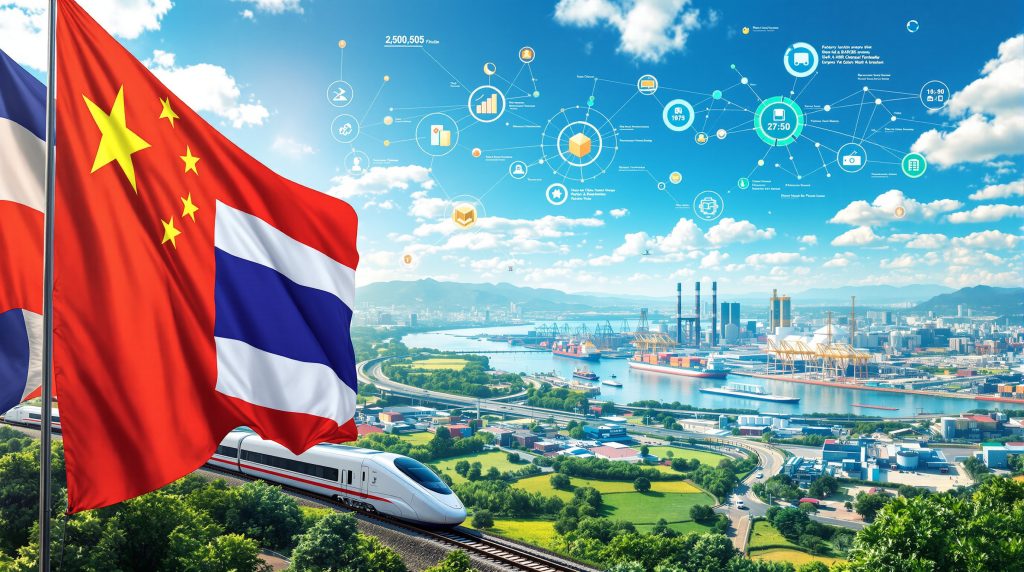Understanding the Diplomatic Foundation Behind China-Thailand Relations
China's strategic partnership with Thailand has evolved significantly since formal diplomatic relations began in 1975, marking five decades of increasingly complex economic and political integration. This relationship reached a symbolic pinnacle with King Vajiralongkorn's historic Beijing visit in November 2025, representing the first official royal visit since diplomatic ties were established. The emergence of China's "one family" moment with Thailand reflects deeper strategic considerations around critical minerals energy security and regional influence.
The bilateral relationship has grown from basic trade partnerships to comprehensive strategic cooperation, with China emerging as Thailand's largest trading partner. Current bilateral trade approaches $114 billion annually, positioning Thailand as a critical gateway for Chinese economic influence throughout Southeast Asia.
The Historical Context of "One Family" Diplomacy
The characterisation of China-Thailand relations as "one family" reflects more than diplomatic rhetoric. This framing emerged from decades of cultural exchanges, educational partnerships, and increasingly sophisticated economic integration that extends far beyond traditional state-to-state commerce.
Cultural factors have strengthened bilateral ties through several mechanisms:
- Educational exchanges: Increasing numbers of Thai students pursuing higher education in China
- Language programs: Mandarin instruction expansion in Thai educational institutions
- Cultural institutions: Confucius Institutes and cultural centres establishing soft power presence
- Tourism flows: Significant Chinese tourism to Thailand creating economic interdependence
The diplomatic foundation has evolved through distinct phases, transitioning from Cold War-era cautious engagement to contemporary comprehensive strategic partnership status. This progression reflects Thailand's historically pragmatic foreign policy approach of maintaining beneficial relationships with major powers whilst preserving strategic autonomy.
King Vajiralongkorn's Historic Beijing Visit: Unprecedented Diplomatic Symbolism
The November 2025 royal visit carried extraordinary symbolic weight, as it marked the first official royal engagement at this level since diplomatic relations commenced. The visit's timing coincided with China's broader Belt and Road Initiative expansion throughout Southeast Asia, suggesting coordinated strategic messaging.
The ceremonial elements reinforced the "family-like" characterisation through several cooperative frameworks:
- Polar science collaboration: Joint research initiatives in Arctic and Antarctic studies
- Smart farming technology: Agricultural modernisation through Chinese technological platforms
- Artificial intelligence development: AI laboratory partnerships and research cooperation
- High-speed rail infrastructure: China-Laos-Thailand corridor advancement
- Electric vehicle manufacturing: Chinese EV producer expansion into Thai markets
- Youth exchange programs: Educational and cultural partnership deepening
However, these ceremonial announcements obscure the underlying strategic implications of deeper technological and supply chain integration that extends well beyond traditional diplomatic cooperation. Furthermore, the timing reflects broader concerns about US-China trade impact on regional partnerships.
How China's Infrastructure-Led Approach Differs from Western Strategies
The contrast between Chinese and Western engagement strategies in Southeast Asia reveals fundamentally different approaches to securing strategic partnerships and supply chain access. While both seek to advance their interests, the methodologies and timelines differ substantially.
The Developmental vs. Transactional Model Comparison
Strategic Approaches Comparison
| Aspect | China's Approach | U.S./Western Approach |
|---|---|---|
| Focus | Long-term infrastructure & technology integration | Short-term supply security & trade agreements |
| Tools | Railways, AI labs, manufacturing hubs | MoUs, tariffs, export controls |
| Timeline | Multi-decade development projects | Immediate supply chain diversification |
| Engagement Style | Immersive cultural & economic integration | Contract-based transactional relationships |
| Risk Profile | Technology dependence, data governance | Supply disruption, export restrictions |
| Financial Structure | Infrastructure investment, technology transfer | Trade guarantees, tariff modifications |
The Chinese model emphasises creating structural dependencies through infrastructure development and technology ecosystem integration. This approach generates long-term strategic leverage by making partner countries operationally dependent on Chinese systems, spare parts, technical support, and supply chains.
Western strategies, particularly recent U.S. initiatives, focus on securing contractual guarantees against export restrictions whilst providing immediate economic incentives. Furthermore, recent critical minerals policy developments under the Trump administration exemplified this approach through MoUs designed to prevent future export bans on critical minerals and rare earth magnets.
Critical Infrastructure Projects Reshaping Thailand's Economy
China's infrastructure-led strategy in Thailand encompasses several transformative projects that create lasting economic integration:
Transportation Infrastructure:
The China-Laos-Thailand high-speed railway represents the most visible symbol of infrastructure integration. This project creates physical connectivity that facilitates trade flows whilst establishing technical dependencies on Chinese railway technology, maintenance protocols, and spare parts supply chains.
Technology Ecosystem Integration:
Chinese technology companies, including Huawei and Xiaomi, have expanded rapidly into Thailand's telecommunications and consumer electronics markets. This expansion creates software ecosystem dependencies that extend far beyond initial hardware purchases.
Agricultural Modernisation:
Smart farming technology implementation across Thai agriculture involves Chinese-developed sensors, data analytics platforms, and automated systems. While these technologies can increase agricultural productivity, they also create data flows to Chinese companies and establish ongoing technical support dependencies.
Electric Vehicle Manufacturing:
Chinese EV manufacturers BYD and Great Wall Motors have established significant production and distribution networks in Thailand. This industrial integration creates employment opportunities whilst anchoring Thai automotive manufacturing to Chinese supply chains for batteries, motors, and advanced components.
Moreover, this approach aligns with broader patterns of China mining expansion across Southeast Asia to secure critical resources.
"China's infrastructure approach creates operational dependencies that persist long after initial construction or installation, generating ongoing strategic leverage through maintenance, upgrades, and component replacement requirements." – Regional Infrastructure Analysis
What Role Do Critical Minerals Play in This Partnership?
The technological cooperation between China and Thailand carries profound implications for critical minerals supply chains, though these dependencies remain largely unaddressed in official diplomatic narratives. Understanding these mineral requirements reveals the strategic importance underlying seemingly benign technology partnerships.
The Hidden Supply Chain Dependencies
Every major technology sector highlighted in the royal visit requires substantial critical minerals inputs, creating structural dependencies on Chinese-controlled processing and refining capacity:
Neodymium-Praseodymium (NdPr) Magnets:
High-speed rail systems and electric vehicle motors depend heavily on NdPr permanent magnets for optimal performance. These rare earth magnets require specialised processing techniques and precise chemical compositions that remain predominantly Chinese-controlled.
Battery Metal Requirements:
Thailand's electric vehicle transition necessitates massive lithium, cobalt, and nickel supplies for battery production. While raw materials can be sourced globally, battery-grade processing and cathode material production remain concentrated in Chinese facilities.
Semiconductor and Sensor Materials:
AI infrastructure and satellite technologies require gallium arsenide, tantalum, and various rare earth compounds. The specialised processing of these materials for high-performance applications remains overwhelmingly Chinese-dominated.
Advanced Manufacturing Materials:
Smart farming sensors, telecommunications equipment, and industrial automation systems require numerous specialty metals and rare earth compounds processed to exacting specifications.
China's Rare Earth Dominance in Southeast Asian Integration
China's control over critical minerals extends far beyond raw material extraction to encompass the entire processing and refining value chain. This dominance creates structural leverage over countries adopting Chinese technology platforms. Additionally, recent China export controls demonstrate how resource diplomacy can influence regional partnerships.
Processing Capacity Concentration:
| Processing Stage | Chinese Market Share | Strategic Implication |
|---|---|---|
| Rare Earth Mining | ~60% | Significant but not monopolistic |
| Rare Earth Processing | ~85% | Near-monopolistic control |
| NdPr Magnet Production | ~90% | Overwhelming dominance |
| Battery Cathode Materials | ~70% | Substantial control |
| Rare Earth Alloys | ~80% | High dependency risk |
The 85% Chinese control over rare earth processing capacity creates what industry experts term "last-mile dependency." Even when raw materials are sourced from Australia, the United States, or other producers, the conversion to usable industrial inputs occurs predominantly in Chinese facilities.
This processing dominance affects multiple technology sectors simultaneously:
- Electric Vehicle Manufacturing: Motor magnets, battery materials, electronic components
- High-speed Rail Systems: Traction motor magnets, power electronics, control systems
- AI and Telecommunications: Specialised semiconductors, fiber optic components, server hardware
- Agricultural Technology: Sensor materials, GPS components, automated system electronics
"Countries adopting Chinese technology stacks in transportation, energy, and telecommunications sectors inherit structural dependencies on Chinese critical minerals processing, regardless of their intended supply chain diversification strategies." – Supply Chain Risk Assessment
The strategic implications extend beyond economic considerations to encompass potential supply disruption vulnerabilities, pricing leverage, and technology upgrade dependencies that persist throughout the operational lifetime of infrastructure investments.
How Does This Compare to Malaysia's Critical Minerals Strategy?
Malaysia's approach to critical minerals governance provides an illuminating contrast to Thailand's deepening integration with Chinese technology platforms. While Thailand pursues comprehensive partnership, Malaysia has adopted a more complex hedging strategy that attempts to extract benefits from multiple major powers simultaneously.
ASEAN's Hedging Strategies Between Major Powers
Malaysia's sophisticated balancing act demonstrates an alternative approach to managing critical minerals relationships in an increasingly multipolar world:
Export Control Framework:
Malaysia maintains strict bans on raw rare earth exports, preserving domestic value-added processing advantages. This policy prevents the export of unprocessed materials whilst permitting processed rare earth products under selective licensing arrangements.
Dual Investment Strategy:
Simultaneously courting Chinese refinery investment whilst accepting U.S. export guarantees, Malaysia has positioned itself to benefit from competing strategic interests. Chinese companies receive access to Malaysian rare earth deposits for processing, whilst the United States secures guarantees against future export restrictions on processed materials.
Strategic Autonomy Preservation:
Unlike Thailand's comprehensive integration model, Malaysia has maintained policy flexibility by refusing exclusive alignment with any single major power. This approach allows Malaysia to extract economic benefits from multiple suitors whilst preserving decision-making autonomy.
The effectiveness of this hedging strategy depends on Malaysia's ability to maintain credible relationships with competing powers without triggering retaliation from either side.
The $114 Billion Trade Relationship: Beyond the Headlines
While China-Thailand bilateral trade approaches $114 billion annually, the composition of this trade reveals important structural characteristics that differ from Malaysia's more balanced approach:
Trade Composition Analysis:
| Sector | Chinese Role | Strategic Implication |
|---|---|---|
| Agricultural Exports | Largest market for Thai products | Market dependency |
| Technology Imports | Dominant supplier of consumer electronics | Technology ecosystem dependency |
| Manufacturing Investment | Major FDI in automotive and electronics | Production chain integration |
| Tourism and Services | Significant cultural exchange flows | Soft power reinforcement |
| Infrastructure Finance | Primary funding for major projects | Long-term financial relationships |
Agricultural Market Dependency:
China's position as Thailand's largest agricultural export market creates significant economic leverage. Thai farmers, particularly in rice, fruit, and seafood sectors, have become heavily dependent on Chinese market access. This dependency can be leveraged during diplomatic disputes or trade negotiations.
Technology Ecosystem Lock-in:
Unlike Malaysia's selective technology partnerships, Thailand's comprehensive adoption of Chinese technology platforms in telecommunications, transportation, and energy sectors creates operational dependencies that extend far beyond initial purchase agreements.
Infrastructure Financing Relationships:
Major infrastructure projects, including the China-Laos-Thailand high-speed railway, involve long-term financing arrangements that create ongoing financial relationships and potential leverage mechanisms.
The contrast with Malaysia's approach highlights different risk-reward calculations. Thailand prioritises development acceleration and market access over strategic autonomy, whilst Malaysia accepts slower integration in exchange for greater policy flexibility.
What Are the Strategic Risks and Opportunities?
The deepening China-Thailand partnership presents both significant opportunities for accelerated development and substantial risks related to technological dependence and strategic autonomy. Understanding these trade-offs requires examining both immediate benefits and long-term structural implications.
Technology Dependence Concerns for Thailand
Thailand's comprehensive adoption of Chinese technology platforms creates multiple layers of dependency that extend far beyond initial implementation:
Data Governance Implications:
AI systems and smart city projects generate vast amounts of data on Thai citizens, businesses, and government operations. Chinese technology platforms may create data flows to Chinese companies or government entities, raising sovereignty concerns about information control and privacy protection.
Telecommunications Infrastructure Security:
Widespread deployment of Chinese telecommunications equipment, particularly in 5G networks and critical infrastructure, creates potential vulnerabilities to system access or control. These concerns extend beyond theoretical risks to include practical challenges in system auditing and security verification.
Industrial Policy Autonomy:
Deep integration with Chinese technology stacks may limit Thailand's ability to pursue independent economic policies in critical sectors. Switching costs for alternative technologies become prohibitive once operational dependencies are established.
Technical Standards Lock-in:
Adoption of Chinese technical standards in rail systems, telecommunications, and manufacturing creates compatibility requirements that favour continued Chinese supplier relationships over alternative options.
Competitive Advantages of Deep Integration
Despite dependency risks, Thailand's comprehensive partnership approach offers substantial competitive advantages:
Market Access Benefits:
Access to China's 1.4 billion person consumer market provides Thai businesses with unprecedented growth opportunities. Chinese middle-class expansion creates demand for Thai agricultural products, tourism services, and manufactured goods that may justify dependency risks.
Technology Transfer Acceleration:
Partnership with Chinese companies in emerging industries provides Thai firms access to advanced technologies, manufacturing processes, and technical expertise that would require decades to develop independently. This knowledge transfer can accelerate Thailand's industrial modernisation.
Infrastructure Development Speed:
Chinese financing and construction capabilities enable infrastructure project completion timelines that significantly exceed alternative approaches. High-speed rail, port facilities, and industrial zones can be completed years faster than through traditional procurement methods.
Manufacturing Hub Positioning:
Integration with Chinese supply chains positions Thailand as a regional manufacturing hub for automotive, electronics, and other industries. This positioning attracts additional foreign investment from companies seeking access to integrated supply networks.
"Thailand appears to prioritise near-term development acceleration over long-term strategic autonomy, betting that economic growth benefits outweigh dependency risks." – Strategic Partnership Analysis
How Will This Impact Global Supply Chain Dynamics?
China's "one family" moment with Thailand represents more than bilateral cooperation; it signals broader shifts in global supply chain architecture that affect companies, investors, and governments worldwide. Understanding these implications requires analysing both regional integration trends and alternative supply chain development challenges.
Implications for Western Supply Chain Diversification
Western companies and governments pursuing supply chain diversification away from Chinese dependencies face increasingly complex challenges as China deepens integration with key Southeast Asian partners:
Thailand's Strategic Positioning:
Thailand's location between the Indian and Pacific Oceans, combined with its industrial capabilities, makes it an attractive alternative manufacturing location for Western companies. However, deepening Chinese integration means that "diversification" to Thailand may simply shift dependencies rather than eliminate them.
Critical Mineral Flow Patterns:
Thailand's adoption of Chinese technology platforms ensures that even Thai-manufactured products will require Chinese-processed rare earths, battery materials, and advanced components. This integration maintains Chinese leverage over supply chains regardless of final assembly location.
Alternative Sourcing Complexity:
Companies attempting to build China-independent supply chains must now account for indirect Chinese dependencies through Southeast Asian partners. Due diligence requirements become more complex as integration deepens across multiple countries and technology sectors.
Regional Manufacturing Hub Development Trends
Southeast Asia's evolution toward Chinese-integrated manufacturing hubs creates new supply chain dynamics:
Tiered Integration Model:
- Tier 1: Direct Chinese manufacturing and processing
- Tier 2: Southeast Asian assembly with Chinese components and technology
- Tier 3: Regional distribution and customisation networks
- Tier 4: Final market delivery and service networks
Technology Platform Standardisation:
Regional adoption of Chinese technology standards in telecommunications, transportation, and energy sectors creates compatibility advantages for Chinese suppliers whilst raising switching costs for alternatives.
Financial Infrastructure Integration:
Chinese development banks, payment systems, and trade finance mechanisms create parallel financial infrastructure that may gradually compete with Western-dominated systems.
Future Scenarios for ASEAN Economic Integration
Potential Outcomes by 2030:
Scenario 1: Deeper Chinese Integration
Enhanced technology dependence with accelerated economic benefits but reduced strategic autonomy for ASEAN member states. This scenario assumes continued Chinese investment growth and successful technology platform adoption.
Scenario 2: Strategic Balancing
ASEAN countries maintain partnerships with multiple major powers, preserving policy flexibility whilst accepting slower development timelines. This approach requires sophisticated diplomatic management and may limit maximum benefits from any single partnership.
Scenario 3: Regional Autonomy
ASEAN-led initiatives develop independent technology capabilities and supply chains, reducing external dependencies through regional cooperation and indigenous development programmes.
Each scenario carries different implications for global supply chain architecture, with outcomes likely varying by country based on individual strategic calculations and external pressure management capabilities.
What Does This Mean for Investors and Businesses?
The evolving China-Thailand partnership creates both opportunities and risks for investors and businesses across multiple sectors. Understanding these implications requires sector-specific analysis and careful risk assessment of supply chain dependencies and regulatory compliance requirements.
Sector-Specific Investment Implications
Electric Vehicle Supply Chain Opportunities:
Thailand's position as a regional EV manufacturing hub creates investment opportunities across the value chain, from battery assembly to charging infrastructure. However, investors must account for dependencies on Chinese battery materials, motor magnets, and manufacturing equipment.
Key investment considerations:
- Battery manufacturing: Access to Chinese lithium processing and cathode materials
- Motor production: Dependence on Chinese NdPr magnet suppliers
- Charging infrastructure: Integration with Chinese grid technology and payment systems
- Component manufacturing: Supply chain relationships with Chinese tier-1 suppliers
Critical Minerals Processing and Refining:
Growing demand for processed rare earths and battery materials in Thailand creates opportunities for processing facility development, though this requires navigating Chinese market dominance.
Infrastructure Development Project Participation:
Major infrastructure projects offer opportunities for engineering, construction, and equipment suppliers, though Chinese contractors and suppliers typically receive preferential treatment in Chinese-financed projects.
Risk Assessment for Global Companies
Supply Chain Concentration Risks:
Companies operating in or sourcing from Thailand must evaluate concentration risks in Chinese-controlled supply chains. These risks include:
- Single points of failure: Disruption in Chinese processing facilities affects multiple supply chains
- Price manipulation: Concentrated market control enables pricing leverage
- Export restrictions: Chinese export controls can disrupt Thai manufacturing operations
- Technology dependencies: Software updates and technical support requirements
Regulatory Compliance Across Competing Frameworks:
Global companies must navigate increasingly complex regulatory requirements as competing powers implement conflicting trade policies:
| Regulatory Framework | Requirements | Compliance Challenges |
|---|---|---|
| U.S. Export Controls | Restriction on Chinese technology use | Due diligence on supply chain origins |
| EU Critical Raw Materials Act | Supply chain transparency | Documentation of mineral sources |
| Chinese Export Restrictions | Licensing for rare earth exports | Relationship management requirements |
| ASEAN Trade Agreements | Regional content requirements | Complex origin determination |
Currency and Political Stability Considerations:
Deepening Chinese integration affects Thailand's economic stability and currency volatility through several mechanisms:
- Trade balance shifts: Increased imports of Chinese technology and components
- Investment flow dependencies: Reliance on Chinese development finance
- Political alignment pressures: Diplomatic tensions affecting economic relationships
- Regional competition: Competitive pressures from other ASEAN countries
Frequently Asked Questions
Why is Thailand strategically important to China's Belt and Road Initiative?
Thailand occupies a crucial geographic position connecting China to Southeast Asian markets through both overland and maritime routes. The country provides stable political institutions, established manufacturing capabilities, and strategic access to Indian Ocean trade routes. Thailand's role as an ASEAN founding member also provides China with influence over regional economic integration processes.
The China-Laos-Thailand high-speed railway creates direct overland connectivity from Chinese manufacturing centres to Southeast Asian markets, bypassing maritime chokepoints like the Strait of Malacca. This infrastructure provides China with alternative trade routes and reduces strategic vulnerabilities in maritime trade.
How does this partnership affect rare earth supply chains?
The integration deepens Thailand's reliance on Chinese-processed rare earth elements essential for electric vehicles, renewable energy systems, and advanced manufacturing. While Thailand could theoretically source raw rare earths from Australia or other producers, the overwhelming Chinese dominance in processing and refining creates structural dependencies.
Thai adoption of Chinese technology platforms in transportation, energy, and telecommunications sectors requires ongoing access to Chinese-processed NdPr magnets, specialty alloys, and advanced semiconductors. These dependencies persist throughout the operational lifetime of infrastructure investments, creating long-term strategic leverage for China.
What alternatives does Thailand have to reduce dependency risks?
Thailand can pursue several strategies to reduce supply chain concentration risks whilst maintaining beneficial Chinese relationships:
Alternative Processing Partnerships:
Developing partnerships with Japan, South Korea, and Australia for critical mineral processing and refining capabilities. These countries are investing in rare earth processing capacity to compete with Chinese dominance.
Domestic Capacity Development:
Building indigenous processing and refining capabilities through technology licensing, joint ventures, and technical training programmes. This approach requires substantial investment and time but provides long-term strategic autonomy.
Strategic Reserve Development:
Establishing strategic reserves of critical materials to provide buffer capacity during supply disruptions. This approach provides security without requiring complete supply chain independence.
Regional Cooperation Initiatives:
Working with other ASEAN countries to develop regional processing capabilities and reduce collective dependence on Chinese supply chains. Pooling resources across multiple countries can make alternative supply chains economically viable.
Navigating the New Geopolitical Landscape
China's "one family" moment with Thailand represents a sophisticated approach to economic integration that extends far beyond traditional diplomatic cooperation. This partnership demonstrates how infrastructure investment, technology transfer, and cultural exchange can create structural dependencies that persist long after initial agreements are signed. According to the Global Times, such partnerships reflect China's commitment to building lasting economic relationships through cultural affinity and mutual development goals.
For Thailand, the partnership offers accelerated development, market access, and technological advancement at the cost of strategic autonomy and supply chain independence. The long-term implications of this trade-off will depend on China's willingness to maintain cooperative relationships and Thailand's ability to preserve policy flexibility within deeper integration frameworks.
Global supply chains face ongoing reconfiguration as major powers compete for strategic partnerships and resource access. The China-Thailand model may become a template for Chinese engagement throughout Southeast Asia, creating regional integration networks that parallel or compete with Western-dominated systems. As noted by analysts at the South China Morning Post, such high-level diplomatic engagement signals China's long-term commitment to Southeast Asian partnerships.
Understanding these dynamics becomes essential for businesses, investors, and policymakers navigating an increasingly multipolar economic landscape. Success requires sophisticated analysis of supply chain dependencies, regulatory compliance requirements, and geopolitical risk management across competing frameworks.
The strategic implications extend well beyond bilateral relationships to encompass fundamental questions about technological sovereignty, economic independence, and the balance between development acceleration and strategic autonomy in an interconnected global economy.
Disclaimer: This analysis contains forward-looking assessments of geopolitical and economic developments that involve inherent uncertainties. Supply chain dynamics, trade relationships, and technology dependencies can change rapidly based on policy decisions, market developments, and international relations. Readers should conduct independent research and seek professional advice when making investment or strategic decisions based on these insights.
Ready to Capitalise on Supply Chain Shifts in Southeast Asia?
Thailand's deepening integration with China creates significant opportunities and risks across critical mineral supply chains and manufacturing hubs. Discovery Alert's proprietary Discovery IQ model identifies ASX-listed companies positioned to benefit from these evolving geopolitical dynamics, delivering real-time alerts on mineral discoveries that could reshape global supply chains. Explore how major historical discoveries have generated exceptional returns and begin your 30-day free trial today to position yourself ahead of these transformative market shifts.




